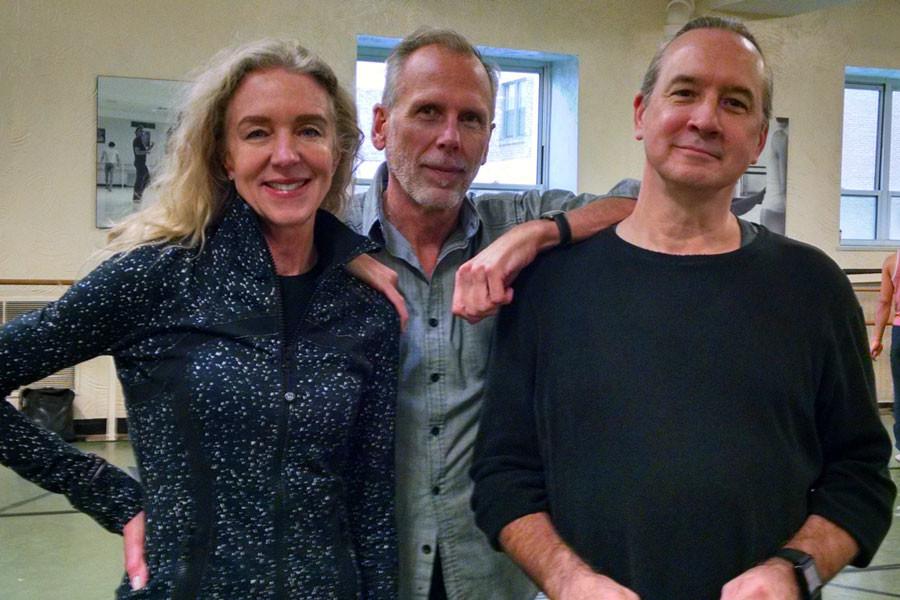Alumni help produce story ballet “The Day of the Gypsy”
Northwestern alumni Laura Schwenk-Berman (Communication ’96) and Jeff Bauer (Communication ’81), pictured left and middle, and freelance choreographer Gordon Peirce Schmidt, pictured right, put together the upcoming production The “Day of the Gypsy.” The show highlights the unique genre of gypsy jazz.
November 18, 2015
A&E
“Day of the Gypsy,” a fairytale story ballet that will premiere this weekend at Chicago’s Harris Theater, highlights the unique music genre of gypsy jazz.
“Gypsy jazz was a style of music developed by Jean ‘Django’ Reinhardt in the 1930s and 40s,” said Gordon Peirce Schmidt, the director and choreographer of the show. “He was a gypsy and he loved the music of the famous trumpet player, Louis Armstrong. So he started learning to play jazz and he came up with the genre of gypsy jazz.”
Three years ago, Schmidt started thinking about the concept of incorporating the energetic gypsy jazz into a show with artistic associates Laura Schwenk-Berman (Communication ‘96) and Jeff Bauer (Communication ‘81). After two test runs of concert versions of the show in Grand Rapids, Michigan and Chicago, they decided to take the concept to another level by adding in dance.
“It interweaves the various disciplines of performing and visual arts,” Schwenk-Berman said. “There’s a jazz band and it’s a story ballet — a story told from movement. And I think movement is one of the most honest expressions there is.”
“Day of the Gypsy” will be produced by Chicago’s RPM Productions, a nonprofit theater company. It combines gypsy jazz music with folk-infused ballet dancing to tell the story of a gypsy woman as she comes across an evil gypsy character. The show’s music and dance interact to create a complicated love story filled with magic and a fight between good and evil, Berman said.
“I’d say the gypsy woman is a free spirit,” Schmidt said. “Gypsies are wanderers. They come into our lives, affect them and then they’re gone.”
The story ballet features 13 dancers and five musicians. John Jorgenson wrote the music for the show and will perform with the John Jorgenson Quintet. The musicians will use instruments including a rhythm guitar, violin and a bass guitar.
“You’d be surprised at how compelling it is,” Schmidt said. “It’s very passionate music and it’s amazing how the musicians can weave a story with their music.”
As the main choreographer for the show, Schmidt focused on studying different types of gypsy folk dancing when deciding what movement to incorporate, he said.
“It’s very athletic choreography,” Schmidt said. “It’s based in contemporary ballet, but there are a lot of folk elements in it. I’m not proficient in gypsy dance, but gypsies are very passionate people, so the choreography has to be very physical.”
The dancers constantly engage in complicated dips, spins and other moves that convey meaning without words, associate choreographer Schwenk-Berman said.
In order to accommodate the complicated choreography, Bauer aimed to create simplified versions of elaborate, tribal gypsy costumes.
Bauer also designed the set of the show. The Harris Theater, a large venue, is transformed into a gypsy camp. Within the story of the play, the passage of time is shown metaphorically through the scenery surrounding the action.
“One of the goals of the space was to introduce a progression,” Bauer said. “The inspiration for that was the phases of the moon. We do have a moon image but instead of doing that literally, I’ve designed it in such a way that the space of the shape changes with drapes and fabrics that fill the stage and fall in.”
Bauer said what he learned at Northwestern years ago has folded into newer and larger things, like the design for this show.
Schwenk-Berman said what she learned at NU has transferred into her professional life as a choreographer.
“Up until that time I had been a ballet dancer and you’re used to people telling you what to do,” Schwenk-Berman said. “But at Northwestern, I was able to develop as a choreographer and a director. I had a wonderful class that taught me a lot about going to the essence of things as an artist, rather than just about the technical aspects of theater.”
The essence of art as a way to connect with others is the main thing that Schmidt wants to get across with “Day of the Gypsy.”
“I think the most important thing for me is that I reach people on an emotional level,” Schmidt said.
Schmidt said the show is accessible to all ages, and is specifically geared toward college students because of the messages about life and decisions that it explores.
“It’s wonderful that students at Northwestern are learning and networking,” Schmidt said. “But for college students, deep inside, there’s often a passion and a question that asks you what you really feel about life. These are mature artists performing, and I think it’s important that college students see something like this.”
Email: [email protected]
Twitter: @amandasvachula


